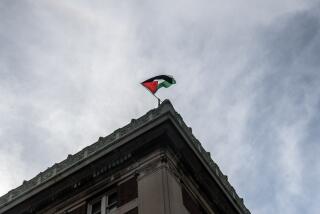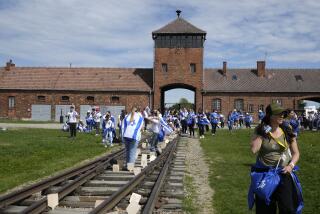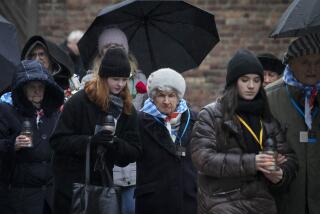Bush Ends Trip to Poland With Auschwitz Visit
- Share via
OSWIECIM, Poland — Vice President George Bush on Tuesday toured Auschwitz and Birkenau, the most notorious Nazi death camp complex of World War II, and, after laying a wreath on the stark stone memorial to the 4 million Jews and Poles who died there, declared it “one of the great monuments in the world.”
The vice president, accompanied by his wife, Barbara, took the tour on a drizzling, overcast day that seemed fitting weather for viewing the artifacts of one of the grimmest chapters of modern history.
“It is so moving that it is very hard to describe it for me,” Bush said, as he stood near the end of the rail spur that brought millions to their deaths in the gas chambers.
“There is no way to express it,” Bush said. “I think everyone that comes here would like to feel that he or she in some way would go away and dedicate themselves to peace and to trying to see that this kind of atrocity would never happen again.”
Bush was concluding a four-day trip to Poland before journeying on to Bonn, Paris, London and Brussels for meetings with West European leaders.
Guided by Ex-Inmate
Bush and his wife were guided through the death camps by Casimir Smolen, director of the camp museum, who was an inmate at Auschwitz from 1940 until its liberation in 1945. The vice president, Smolen said later, asked “good questions” throughout the tour, but, for the most part, the Bushes seemed awed and subdued by the spectacle, as most visitors to the museum are.
The Bush party was shown displays of human hair, shorn from gassed women inmates, and the “haircloth” that the Nazis manufactured from it. They saw a display of childrens’ clothing, thousands of pairs of shoes, suitcases, hair brushes, eyeglasses and other possessions stripped from the prisoners before they died.
“Beyond comprehension,” Barbara Bush said as she looked in the display case filled with 5,000 pairs of children’s shoes.
The Bushes seemed particularly horrified at an exhibition in the Jewish Pavilion. They stopped in front of a large photograph of a woman inmate wearing a cardboard sign that said in German, “I Had Relations With a Jew.” Mrs. Bush was visibly upset at a photograph of naked women inmates being marched to their death.
“It’s one of the great monuments of the world, and I’m privileged to have seen it,” the vice president said at the end of the tour. “It’s a horrible reminder of a part of civilization’s past. It’s a reminder that everybody should work to see that we could never have such brutality in the future.”
Bush began his last day in Poland with a press conference in Warsaw, where he characterized his talks with the Polish leadership as “another step in the process of re-engagement with Poland.”
He said his talks with Polish leader Wojciech Jaruzelski had revealed sharp differences, and he repeatedly noted that the United States would be “prepared to do more” to provide material aid to Poland if it was satisfied that the Polish government was committed to lasting political and economic reform.
“You get the distinct feeling that Poland is coming out of a difficult time and is moving forward,” Bush said. He added: “Poland wants a better relationship. I know we do.”
Pressed by reporters on whether he favors the legalization of the banned independent trade union Solidarity, he said “Yes.” He added that while he felt “no inhibitions” in mentioning the trade union while in Poland, a major concern of his trip was to re-establish normal relations with the Communist regime.
“What you try to do,” said Bush, “is try to improve relations, not make them worse.”
More to Read
Get the L.A. Times Politics newsletter
Deeply reported insights into legislation, politics and policy from Sacramento, Washington and beyond. In your inbox twice per week.
You may occasionally receive promotional content from the Los Angeles Times.










